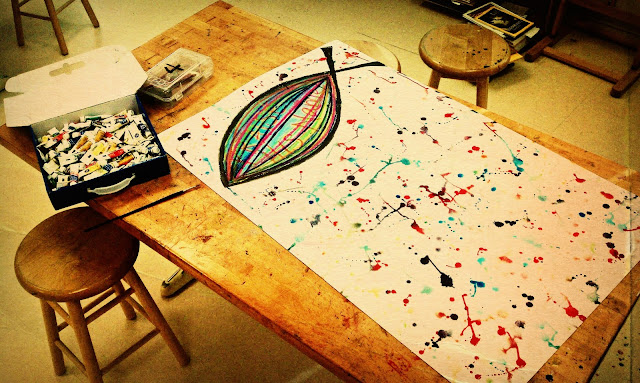... then I'm trying to help my students have perfect practice!!
The courses I teach on the studio side of the course catalog are largely foundational and exploratory in nature. Many of the students I have come through my classes have never had any other art courses, haven't had them in a long time, and might never have any art courses again. My goal is to integrate as much fun as possible and introduce them to as much space to stretch out in in order to help them feel comfortable enough to just create SOMEthing. Just like how practicing writing helps to establish a personal writing voice, practicing art helps students to find the artistic voices that exist within all of them. (Per my own beliefs of faith, since we have all been created in God's likeness, we have all been given the gift of creativity as well as the power of creation. It's just a matter of tapping that part of ourselves in order to awaken it.)
Right now the students of 2D Design are in the throes of project planning and skill-building/scaffodling in order to ready themselves for a very serious project for their level. They are taking almost a whole month for a project based within the art stylings of cubism.
In addition to the actual project that we are doing, I'm also doing my best to offer them training for real world type experiences. Given a single task, the students are always great at going forth and doing something very whole heartedly and completely well. When it comes to longer term and more complex projects? They don't know where to start or how to plan out their time. They become easily overwhelmed and thus crippled by the sheer magnitude of what they want to do. They feel like they can't possibly do whatever it is that they want to do.
This project is broken down into more "bite-size" and easily chewed pieces and chunks while still walking them through the paces of learning fundamentals. They are learning how to use simple drawing/drafting tools like compasses, T-squares, triangles, and scales/rulers to draw the basic shapes in both 2D and 3D forms. They are also learning how to properly tint and shade (for acrylic painting and color gradations) by color mixing with white and black and their selected hues. They are learning about proper care for art materials and tools (brush cleaning, paint portioning), as well as self-evaluation skills that are yielding ability to not only make great judgment calls but also verbalization skills to explain why something is good or not so good.
Something new I'm doing this year is incorporating 1:1 conversations and conferences with the students as a capstone for each stage of the project planning process. Since I have classes of nothing but
millenials, this mode of working, teaching, and advising is really helping to keep them both motivated, encouraged, but still challenged to keep working and trying. There was a time when I felt like the constant and frequent need for feedback was an "annoying" element to have to deal with but it's actually not been so bad. I'm certainly not saying enough of anything that they are being coddled and definitely the critiques I'm offering are not only in the positive realm and more instructional that urge them to be more critical and careful in their brushstrokes and decision making when they are actually doing their work.
Anyway. End soapbox for me. :)
Just wanted to pop on in an effort to keep things a little more up to date on this here blog as well as offer some insight on what is and isn't working in a high school art classroom currently. When I started this blog last winter/spring, there were very few art education blogs focusing on the high school level. The ones I did find had lots of student samples to look at but not as many write-ups on actual lesson plans and even less on actual classroom goings-on, teaching and classroom management tips.
















































